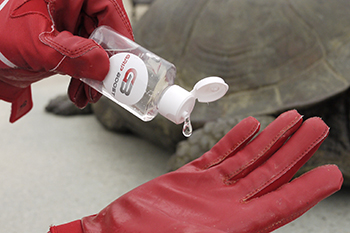
Grip Boost co-founder Matt Furstenburg testing the gel. Courtesy of Faye Levine/A. James Clark School of Engineering.
Unfortunately, this stick doesn’t last tooU long. To combat this, chemical and bio-molecular engineers from the University of Maryland (UMD) have developed Grip Boost. The product is a quick drying gel that restores a glove’s stickiness.
The stickiness is caused by chitosan, a biopolymer that is highly adhesive and tacky. The chemical is non-toxic, natural, and adheres to skin and cells. This also makes the chemical a perfect first aid tool and has been marketed in another form to stop bleeding without bandages.
The research team, led by Prof. Srinicasa Raghavan, have now ensured that the product is NCAA-complainant. This means that it will not leave residue on the ball or give an unfair advantage. To achieve this compliance, the team has tested that the gel’s stickiness is similar to existing gloves matching friction coefficients, tack, and residue tests. Additionally, the chemical can be easily removed as it is soluble in alcohol.

GripBoost is a quick-drying polymer gel that brings the stick back into football gloves. Courtesy of A. James Clark School of Engineering.
This alcohol solubility has also made application similar to antibacterial gels. A small amount is put on the gloves and then rubbed on as a thin film. The alcohol gel then evaporates in seconds leaving the polymer behind.
Matt Furstenburg is the cofounder of Grip Boost, former Baltimore Ravens tight end, and UMD alumni. He said, “Depending on your position and the game, [new gloves] could last anywhere from a few weeks to only a few plays before the [original] coating wears down … In the NFL, I would go through a pair of gloves every three or four days.”
The $20 to $80 price tag for the gloves is no issue to a professional player, but for youths it can get rather pricy. Luckily, the gel promises to make the old gloves act as it did the day it was purchased.
Much like 3M’s “useless” glue that led to the boom of sticky notes, this new polymer can prove to have many hidden abilities. After all, it has already proven its use in sports and medicine. Perhaps as a gel it can turn any paper or into a sticky note making 3M’s invention instantly out of date? Or perhaps it can be used in manufacturing to increase robot grips or replace packaging adhesives with a biodegradable alternative? What uses can you think of for the grip gel? Comment below.
Source University of Maryland 1 & University of Maryland 2